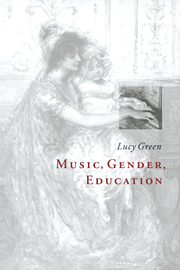Book contents
- Frontmatter
- Contents
- Acknowledgments
- 1 Introduction
- PART I MUSICAL MEANING AND WOMEN'S MUSICAL PRACTICE
- PART II GENDERED MUSICAL MEANING IN CONTEMPORARY EDUCATION
- 6 Affirming femininity in the music classroom
- 7 From affirmation to interruption of femininity in the music classroom
- 8 Threatening femininity in the music classroom
- 9 The music curriculum and the possibilities for intervention
- Bibliography
- Index
8 - Threatening femininity in the music classroom
Published online by Cambridge University Press: 20 November 2009
- Frontmatter
- Contents
- Acknowledgments
- 1 Introduction
- PART I MUSICAL MEANING AND WOMEN'S MUSICAL PRACTICE
- PART II GENDERED MUSICAL MEANING IN CONTEMPORARY EDUCATION
- 6 Affirming femininity in the music classroom
- 7 From affirmation to interruption of femininity in the music classroom
- 8 Threatening femininity in the music classroom
- 9 The music curriculum and the possibilities for intervention
- Bibliography
- Index
Summary
INTRODUCTION
Composition as a general classroom activity has only recently been systematically included in the English school. Musicians and educators had begun to argue for its necessity as a part of a balanced music education during the 1960s, and it gradually entered the curriculum through the ensuing decades. The Schools Council project of the late 1970s provided one major boost, and composition was also formally ratified by Her Majesty's Inspectorate in 1985. Following this it was incorporated in the 1986 GCSE National Criteria, and finally in the 1992 National Curriculum for Music. In all these contexts, composition has been used as a generic term to include individual and group composition as well as improvisation, notated in any form, or unnotated. I will continue to adopt this broad definition in what follows.
Owing to its relative novelty in the school setting, composition is not bolstered by a long history of educational debate or a variety of recognised pedagogic methods, such as surround performance, music appreciation or many other classroom activities. Nor is it supported by any external, international, graded systems of examination such as those run by the Associated Board of the Royal Schools of Music (see Chapter 7, n. 9, p. 188 above). The notorious difficulty of judging composition, which has often resulted in the demise and pauperisation of composers and improvisers who were to be recognised only after their deaths, has made its own contribution to the lack of formal mechanisms or even vocabulary for the assessment of composition in education.
- Type
- Chapter
- Information
- Music, Gender, Education , pp. 193 - 229Publisher: Cambridge University PressPrint publication year: 1997



